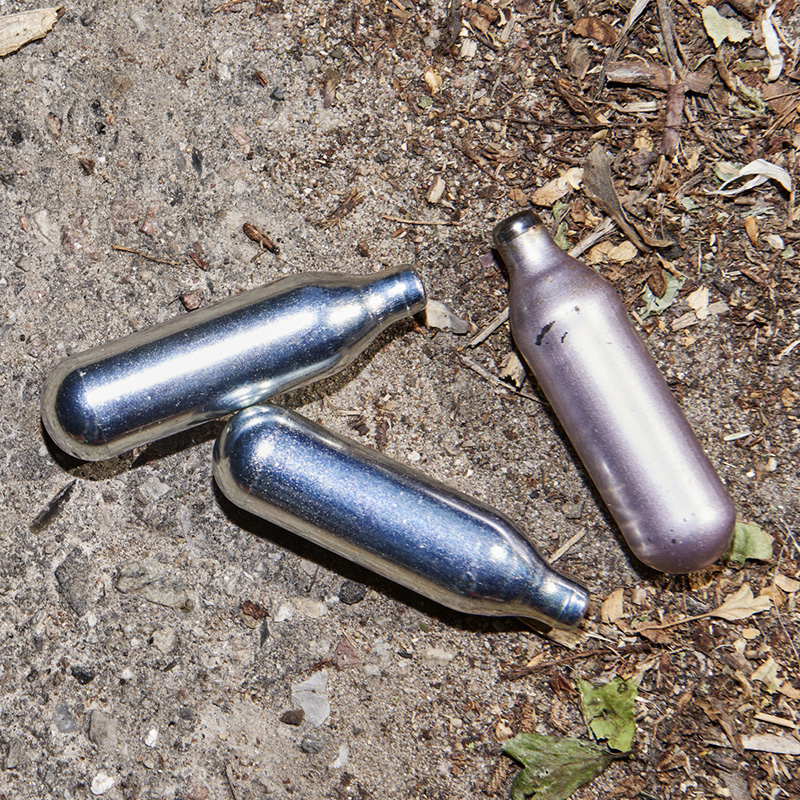Many abused substances are readily available for purchase in local stores. You may even have one of the most popular substances of choice for teenagers and young adults in your kitchen at this very moment. Few of us give a second thought to having a can of whipped cream in the fridge. When inhaled, these “whippets” can lead to serious health concerns and addiction in young teens and adults.
What Are Whippets?
Whippets, also known as whip-its, laughing gas, nitro, nangs, noz, and hippy crack, is one of the many street names for the process of inhaling nitrous oxide to get high. Nitrous oxide is a gas consisting of nitrogen and oxygen that has traditionally been used for pain relief and sedation. [1]Emmanouil, D. E., & Quock, R. M. (2007). Advances in understanding the actions of nitrous oxide. Anesthesia progress, 54(1), 9–18. https://doi.org/10.2344/0003-3006(2007)54[9:AIUTAO]2.0.CO;2
Unfortunately, the abuse of this gas began quickly after its discovery, prominently occurring among medical and dental professionals. Several stories have emerged from this period that described laughing gas parties attended by members of high society.
In time, medical students gained access to nitrous oxide until it became available for use by the general public. [2]Ehirim, E. M., Naughton, D. P., & Petróczi, A. (2018). No Laughing Matter: Presence, Consumption Trends, Drug Awareness, and Perceptions of “Hippy Crack” (Nitrous Oxide) among Young … Continue reading More recently, nitrous oxide has been placed in steel cartridges to propel whipped cream from dispensers or for at-home nitrous coffee brewing.
Nitrous oxide is a psychoactive drug that is classified as an inhalant. In fact, nitrous oxide inhalant falls into the same category as huffing glue, spray paint, and poppers. It is abused as a recreational drug because it produces a euphoric high that provides the user a giddy, floating feeling—the same sensation that allows dental patients to feel at ease and happy during dental procedures. This feeling is short-lived—usually only a minute or two—leading users to repeatedly breathe in the nitrous oxide to obtain the feeling once again.
How Are Whippets Used?
While there are many terms for inhaling nitrous oxide, as mentioned above, the term “whippets” is most associated with breathing nitrous oxide gas straight from a whipped topping can. In the most common method, the nozzle is held at an angle, letting only the gas and not the cream escape. When nitrous oxide is breathed in, the euphoric experience is immediate.

While the above method is certainly popular, other methods have found favor over time as the grocery store cans can frost over quickly and create a risk of burns to the hand. One of the more popular methods involves using a balloon and a nitrous oxide cartridge. [3]Thompson, A. G., Leite, M. I., Lunn, M. P., & Bennett, D. L. (2015). Whippits, nitrous oxide and the dangers of legal highs. Practical neurology, 15(3), 207–209. … Continue reading The top of the cartridge is punctured, and the gas is leaked into the balloon, where warm air makes it easier to inhale. The user generally pinches the tip of the balloon, choosing to inhale more when the initial high wears off.
Where Do People Get Whippets?
 It is important to note that whippets are readily available from sources other than whipped cream containers. Non-grocery store whippets are most often seen in steel cartridges that look like small oxygen tanks, available for purchase in stores or online. There are specialized dispensers that can be used that mimic the whipped topping canisters, often sold for commercial or at-home use.
It is important to note that whippets are readily available from sources other than whipped cream containers. Non-grocery store whippets are most often seen in steel cartridges that look like small oxygen tanks, available for purchase in stores or online. There are specialized dispensers that can be used that mimic the whipped topping canisters, often sold for commercial or at-home use.
Some websites also sell canisters specially created to dispense whippets. For this reason, state laws regulate the sale and use of nitrous oxide. [4]Hirvioja, J., Joutsa, J., Wahlsten, P., & Korpela, J. (2016). Recurrent paraparesis and death of a patient with ‘whippet’ abuse. Oxford medical case reports, 2016(3), 41–43. … Continue reading Most prohibit its sale to minors, and some states also criminally prosecute individuals caught distributing the gas. While these laws and restrictions help, there are still several other means to get this gas.
What Is the Appeal of Whippet Use?
Whippets are one of the most common party drugs, often sold openly in balloons at concerts and festivals. Whippets can cause a tingling sensation, especially in the arms or legs. Some users even experience feelings of vibrations or warm sensations. [5]Wu LT, Schlenger WE, Ringwalt CL. Use of nitrite inhalants (“poppers”) among American youth. J Adolesc Health. 2005;37(1):52–60. Use can also make you feel weak or tired, which is why use is also associated with uncoordinated movements, laughter, and numbness.
The effects don’t last long, but they are intense. This draws many users to not only try whippets but continue to use nitrous oxide to achieve that same high. In fact, recent studies have shown that whippets are one of the most popular recreational inhalants of choice. Since nitrous oxide is legal, cheap to purchase, and relatively easy to obtain, it is popular among teenagers.
In fact, many teens feel a misguided sense of security when experimenting with nitrous oxide—it is found in a familiar, household product and the effects seemingly don’t last long. As a result, many teenagers don’t consider the serious side effects that can develop with use, especially prolonged use. In a recent year, the National Institute on Drug Abuse reported that the majority of first-time users were between the ages of 16 and 17. [6]Muller AA, Muller GF. Inhalant abuse. J Emerg Nurs. 2006;32(5):447–8.
Are Whippets Addictive?
Medical research is still exploring the effects of nitrous oxide on our systems and what addictions can be formed with regular use. Some of the research suggests that it has an impact on the body’s opioid receptors. This could be a reason many people are so susceptible to continued nitrous oxide use. [7]Kurtzman TL, Otsuka KN, Wahl RA. Inhalant abuse by adolescents. J Adolesc Health. 2001;28(3):170–80. It is important to note that whippet addiction is largely a psychological dependency. Unlike alcohol or other drugs, whippets don’t cause physical withdrawal symptoms.
How Dangerous Are Whippets?
Whippet use can be extremely dangerous, especially since researchers still don’t have a full understanding of what makes nitrous oxide addictive or what bodily functions it impacts. What we do understand is that nitrous oxide doesn’t work the same way as other drugs.
For example, cocaine and opioids work by tricking the brain into releasing dopamine and serotonin. These substances provide feelings of euphoria, inspiring individuals to use drugs to achieve that quick sensation more often, which can then lead to addiction.
By contrast, after a whippet, the nitrous oxide gas completely cuts off the oxygen supply to the brain. Since its effects only last minutes, repeat inhalation deprives the brain of oxygen over and over again. This provides the euphoric feeling scientists don’t yet fully understand and can have serious long and short-term effects.
Side-effects of Whippet Use
Researchers are still learning about the side effects that occur with whippet use. It affects individuals differently, depending on factors such as weight, size, health status, amount inhaled, frequency of use, and the presence of other drugs in the system.
For example, alcohol is one of many substances that can increase the risk of serious health concerns when used along with whippets, as both substances depress the central nervous system. [8]Wu, L. T., & Ringwalt, C. L. (2006). Inhalant use and disorders among adults in the United States. Drug and alcohol dependence, 85(1), 1–11. https://doi.org/10.1016/j.drugalcdep.2006.01.017 However, a person may go years without serious side effects, while another person may face grave consequences the first time. As a result, it is important to understand both the short and long-term effects of whippets, which are not safe to try even once.
Short-Term Side Effects of Whippets
Immediately after inhalation, most users feel dizzy or confused. They have a higher likelihood of falling or passing out which could lead to additional injuries. Nitrous oxide can cause reckless behavior and poor decision-making after just one use, which could lead to many additional doses and even overdose.
Some first-time users experience hallucinations, seizures, and other serious medical concerns, a risk that increases when nitrous oxide is inhaled quickly, or in a confined space. [9]Ehirim, E. M., Naughton, D. P., & Petróczi, A. (2018). No Laughing Matter: Presence, Consumption Trends, Drug Awareness, and Perceptions of “Hippy Crack” (Nitrous Oxide) among Young … Continue reading It is important to realize that nitrous oxide gas cuts off oxygen to the brain.
Even in short bursts of time, this can cause a great deal of damage. Immediate effects may include:
- Difficulty breathing
- Charge in heart rate
- Sluggishness
- Confusion
- Motor control loss
- Loss of control of bodily functions
- Decrease in blood pressure
- Hallucinations
If the user is breathing in the gas directly from a cartridge tank, they also risk cold burns to the lips, throat, skin, and possibly even the lungs if there is enough pressure. Larger quantities can increase the seriousness of short-term effects by causing fainting, heart attack, seizures, or death from asphyxiation. [10]Thompson, A. G., Leite, M. I., Lunn, M. P., & Bennett, D. L. (2015). Whippits, nitrous oxide and the dangers of legal highs. Practical neurology, 15(3), 207–209. … Continue reading
Long-Term Side Effects of Whippets
Even minimal nitrous oxide use can have lasting, long-term side effects. Long-term effects can include:
- Impaired brain function
- Impaired motor skills
- Incontinence
- Reproductive disruption
- Cardiovascular damage
- Organ damage
- Anemia
- Memory loss
- Depression
- Weakened immune system
- Paralysis
- Death
Brain damage is a significant concern, especially with the knowledge that many whippet users are teenagers. The prefrontal cortex undergoes its most significant developments between the ages of 18-25. [11]McAllister T. W. (2011). Neurobiological consequences of traumatic brain injury. Dialogues in clinical neuroscience, 13(3), 287–300. https://doi.org/10.31887/DCNS.2011.13.2/tmcallister This area of the brain is responsible for processing information and coordinating actions and thoughts.
Whippet use also impacts your body’s ability to produce vitamin B12, which is vital for nerve health, red blood cell production, and body tissue repair. When B12 is blocked, the nerves of the upper and lower extremities are often impacted first. This can cause numbness of the toes or fingers that could become permanent. Birth defects can also occur if used during pregnancy.
Allergic Reactions
Whippets are so dangerous due to the unpredictability of how an individual can react to them. Some individuals are allergic to nitrous oxide and aren’t aware of the allergy until their first attempt.
When used by these individuals, nitrous oxide can cause allergic reactions like:
- Breathing problems
- Chest or throat tightness
- Chills
- Hives
- Swelling of mouth, tongue, or throat
- Blistering or peeling of the skin
Can You Overdose on Whippets?
An overdose happens when too much gas is inhaled at once. Overdoses can happen easily while chasing the brief euphoric sensation whippets provide.
These instances have significant effects on an individual, including:
- Chest tightness
- Choking
- Difficulty breathing
- Bluish tint to toes, fingers, or lips
- Psychosis
- Hallucinations
Too much nitrous gas can also cause your heart rate and blood pressure to spike which can lead to seizure, stroke, heart attack, and significant brain damage. In some cases, this can lead to coma or death. [12]Emmanouil, D. E., & Quock, R. M. (2007). Advances in understanding the actions of nitrous oxide. Anesthesia progress, 54(1), 9–18. https://doi.org/10.2344/0003-3006(2007)54[9:AIUTAO]2.0.CO;2
When Are Whippets Safe?
Whippets are never safe and can cause dangerous effects on the very first try. However, when used in a professional setting, nitrous oxide is a safe sedation method often used by dentists. It can also be used by other doctors for anesthesia, pain management, and even alcohol dependency and withdrawal. Nitrous oxide is only safe in a medical environment where a medical professional is monitoring the patient and ensuring they receive plenty of oxygen.
Signs of Whippet Use
Unlike other drugs where symptoms may last a long time, whippets’ effects are gone within minutes. This means that you often won’t be able to tell someone is under the influence by looking at them unless you catch them in the act or immediately following use.
However, if you fear someone in your life is abusing whippets, there are signs to watch out for:
- Visible dizziness
- Funny odor on breath
- Trouble sleeping
- Vision problems
- Bloodshot eyes
- Chapped lips or face
- Headaches
- Memory loss
You can also be vigilant for non-medical signs of abuse, especially whipped topping cans that produce nothing but liquid, as the gas has been used. In addition, be on the lookout for deflated balloons that have an odd odor.
There Is Help Available

Whippet addiction is very real. It is one of the most easily accessible highs, available for purchase in many grocery, big box, and auto parts stores. At the same time, its short-lived effects cause the user to seek the high more often, risking dangerous effects with each inhale. [13]Ehirim, E. M., Naughton, D. P., & Petróczi, A. (2018). No Laughing Matter: Presence, Consumption Trends, Drug Awareness, and Perceptions of “Hippy Crack” (Nitrous Oxide) among Young … Continue reading It is exceptionally dangerous in that this ease of use and quick high appeal to teenagers.
The teenage mind and body are still in development, and whippets can cause permanent damage they will have to live with for the rest of their life. Psychological dependence can be quite dangerous and is often extremely difficult to break on your own. By seeking treatment, you can work with a care team to determine and evaluate the underlying factors that led to your desire to abuse a substance. From there, your treatment will focus on changing behaviors and thoughts so that you can use healthy coping mechanisms.
References
| ↑1 | Emmanouil, D. E., & Quock, R. M. (2007). Advances in understanding the actions of nitrous oxide. Anesthesia progress, 54(1), 9–18. https://doi.org/10.2344/0003-3006(2007)54[9:AIUTAO]2.0.CO;2 |
|---|---|
| ↑2 | Ehirim, E. M., Naughton, D. P., & Petróczi, A. (2018). No Laughing Matter: Presence, Consumption Trends, Drug Awareness, and Perceptions of “Hippy Crack” (Nitrous Oxide) among Young Adults in England. Frontiers in psychiatry, 8, 312. https://doi.org/10.3389/fpsyt.2017.00312 |
| ↑3 | Thompson, A. G., Leite, M. I., Lunn, M. P., & Bennett, D. L. (2015). Whippits, nitrous oxide and the dangers of legal highs. Practical neurology, 15(3), 207–209. https://doi.org/10.1136/practneurol-2014-001071 |
| ↑4 | Hirvioja, J., Joutsa, J., Wahlsten, P., & Korpela, J. (2016). Recurrent paraparesis and death of a patient with ‘whippet’ abuse. Oxford medical case reports, 2016(3), 41–43. https://doi.org/10.1093/omcr/omw012 |
| ↑5 | Wu LT, Schlenger WE, Ringwalt CL. Use of nitrite inhalants (“poppers”) among American youth. J Adolesc Health. 2005;37(1):52–60. |
| ↑6 | Muller AA, Muller GF. Inhalant abuse. J Emerg Nurs. 2006;32(5):447–8. |
| ↑7 | Kurtzman TL, Otsuka KN, Wahl RA. Inhalant abuse by adolescents. J Adolesc Health. 2001;28(3):170–80. |
| ↑8 | Wu, L. T., & Ringwalt, C. L. (2006). Inhalant use and disorders among adults in the United States. Drug and alcohol dependence, 85(1), 1–11. https://doi.org/10.1016/j.drugalcdep.2006.01.017 |
| ↑9 | Ehirim, E. M., Naughton, D. P., & Petróczi, A. (2018). No Laughing Matter: Presence, Consumption Trends, Drug Awareness, and Perceptions of “Hippy Crack” (Nitrous Oxide) among Young Adults in England. Frontiers in psychiatry, 8, 312. https://doi.org/10.3389/fpsyt.2017.00312 |
| ↑10 | Thompson, A. G., Leite, M. I., Lunn, M. P., & Bennett, D. L. (2015). Whippits, nitrous oxide and the dangers of legal highs. Practical neurology, 15(3), 207–209. https://doi.org/10.1136/practneurol-2014-001071 |
| ↑11 | McAllister T. W. (2011). Neurobiological consequences of traumatic brain injury. Dialogues in clinical neuroscience, 13(3), 287–300. https://doi.org/10.31887/DCNS.2011.13.2/tmcallister |
| ↑12 | Emmanouil, D. E., & Quock, R. M. (2007). Advances in understanding the actions of nitrous oxide. Anesthesia progress, 54(1), 9–18. https://doi.org/10.2344/0003-3006(2007)54[9:AIUTAO]2.0.CO;2 |
| ↑13 | Ehirim, E. M., Naughton, D. P., & Petróczi, A. (2018). No Laughing Matter: Presence, Consumption Trends, Drug Awareness, and Perceptions of “Hippy Crack” (Nitrous Oxide) among Young Adults in England. Frontiers in psychiatry, 8, 312. https://doi.org/10.3389/fpsyt.2017.00312 |




